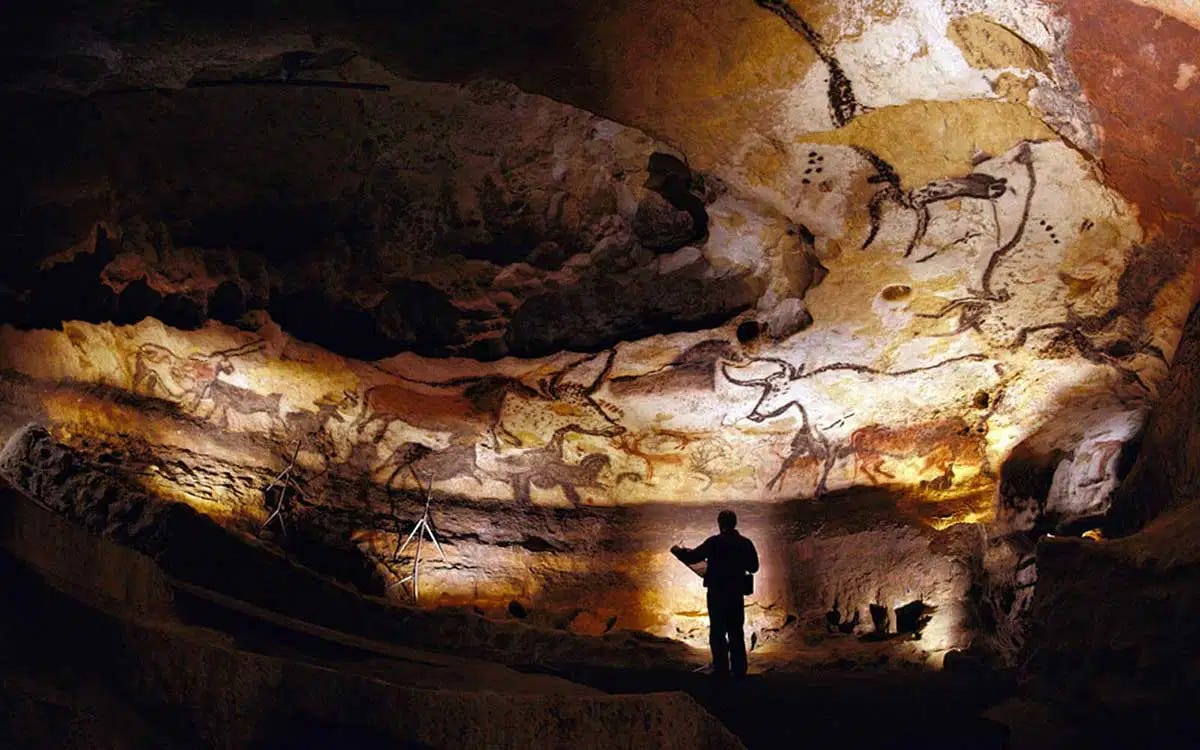Before we could read, before we could write, and yes, even before humans developed advanced skills in speaking, we still found ways to communicate not only amongst ourselves but with the ancestors who would find the footpaths back to this earliest age of human history.
As early as 350,000 years ago, people began differentiating themselves through markings made to their own bodies and goods. These early humans used colorful pigments found in ocher and manganese to communicate important messages of origin, loyalty, and ownership over goods for protection and organization.
It was nearly 77,000 years ago when humans began recording information systematically through the use of tally marks and patterns for purposes of timekeeping, dating, and preserving crucial information. The earliest examples we have of these markings can be found on artifacts such as the
Blombos Ochre Plaque (75,000-77,000 years old.)

40,000 years ago, we see the emergence of paintings and other artistic works like etchings often associated with cave murals but also covering earthenwares, skins, stone, and ivory. These images told stories and preserved crucial information about the earliest activities and rituals of our ancestors and are found throughout most civilizations around the world - proving a rather consistent rate of evolution across great distances.
Not until a relatively recent 8,000 years ago were symbols and the first known language called cuneiform introduced as a way of recording language. This original script born out of Mesopotamia (modern-day Iraq) in the year 3200 BCE was only a rudimentary advancement in writing but served as a point of transition between visual representation of objects (pictures) to symbols representing the sounds of language (alphabet).

In the 8,000 years since written language originally took shape, we have expanded upon it in ways our ancestors could have never imagined. Through the rich diversity of world languages and cultures, we preserve what was once passed through time via the simplicity and often faulty modes of oral tradition and storytelling with a seemingly endless number of mediums.
Mediums.
What are mediums?
Mediums are the materials, objects, platforms, and methods by which we can communicate information. In early histories this included our skin as we marked our identities through the aforementioned pigments and eventually tattoos, the stone walls of caves we marked with paints, the bits of wood, stone, and other materials we were able to leave ticks and notches in as we counted, and then yes, stone and wax tablets that evolved into papyrus and paper for the written language.
Nowadays, we can communicate with one another through a seemingly endless selection of mediums. Moving beyond those early paintings buried within forgotten
caves humans began using imagery for purposes beyond self-expression but for interpersonal and even intercultural purposes such as coinage and postage stamps. Telegrams, newspapers, and perhaps literary journals and magazines too fall under the category of early modern communication. The emergence of these mediums then made way for entirely new ideologies and practices such as advertising and propaganda where we were not only communicating - but doing so with aim.
Time ticks on and we discover the wonder of the telephone, radio, film and television in both their broadcast and entertainment roles. Who can forget novels and music? Surely they are two of our greatest examples of human communication in marriage with expression. What began as a primitive instinct while gathered around the fire is now a behemoth digital industry contained within musical libraries that fit in the palms of our hands.
The most recent innovation in communication, social media, is perhaps the medium which so many of us are most familiar with in this 21st century. And yet, it is in many ways the most revolutionary new medium to emerge in human communication since written language 8,000 years ago.
Social media of course refers to the plethora of websites and apps that allow us to connect with others on an interpersonal level. Facebook, Snapchat, Instagram, TikTok, and so on are all unique and offer their own experience. But their mission is the same: connect people. Even in their short lifetimes, since about 2003 when MySpace ruled the web, they have adapted and changed the ways the global community communicates on and offline.
Since I’ve brought up Social Media, and have thus used the word “media” for the first time, I’d like to take a moment to dive into some semantics.
The word media on its own refers to the collective communication made possible by all of the different mediums we’ve already discussed. So media is actually the plural form of the word medium. Now, I know I have been using medium(s) but the truth is that media and medium(s) are generally accepted as being interchangeable. The reason I am now pointing out that media is the plural of medium, and not sticking with medium(s) from here on out, is because media is our topic of discussion today…And understanding the origins of this word helps us visualize the many various forms or mediums by which we consume media. In short: all the various mediums that exist are what make up media; and somewhere amid all that media are the big fish we call The Media. To be continued…
Next Up: Differences between media and The Media.
Sources and Further Reading on topics mentioned:
https://humanorigins.si.edu/human-characteristics/language-symbols
https://www.history.com/news/prehistoric-cave-paintings-early-humans
https://www.britannica.com/topic/cuneiform







I like a coined Roman nose😏. This is great Abby! Great voice, I’d happily read 10 more
pages of this!
Absolutely fascinating. I can’t wait to see where you take this! It is well known that the manipulation of society, and the minds thereof, through the art of media direction is a powerful influence on not only the culture of today but the very ideals of our society. The very direction of one’s thought process through subliminal messaging is powerful! I am excited to see your work as this continues. Strong work, truly, impressive!